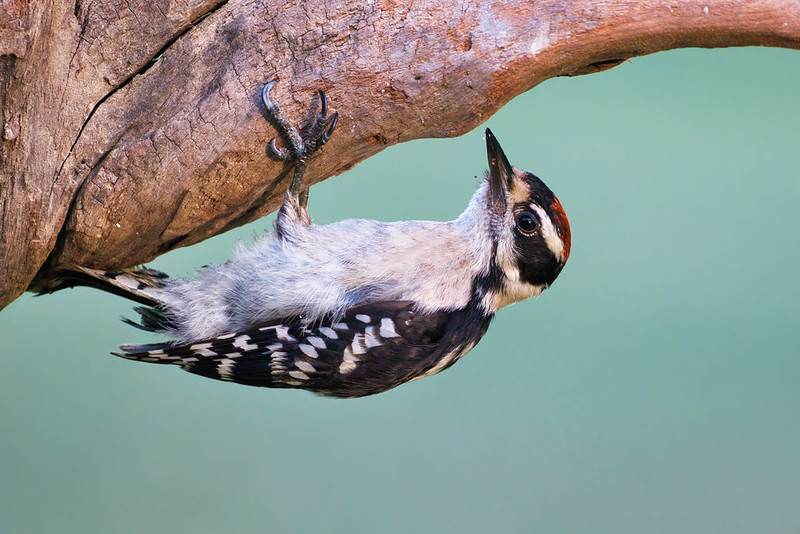Welcome back to my wildlife photography blog! Today, I am thrilled to share with you a captivating moment captured in my yard. This photo features a delightful Downy Woodpecker, showcasing its acrobatic skills as it hangs upside down on a piece of driftwood that I’ve cleverly transformed into a suet feeder. As an avid wildlife photographer, I am constantly amazed by the beauty and diversity of nature that unfolds right outside my door. Join me as we delve into the world of these charming woodpeckers and learn some unique facts about their behavior and habitat.

Setting the Stage:
To capture this image, I stationed myself on my deck, patiently waiting for the Downy Woodpeckers to discover the new suet feeder. Setting up my camera and lens mounted on a tripod, I ensured the stability necessary for crisp and detailed shots. Though I usually prefer to shoot handheld for flexibility, the longer focal length of my 800 mm lens demanded the extra support to maintain stability and achieve the desired composition.
The Downy Woodpecker:
The Downy Woodpecker (Picoides pubescens) is one of North America’s most beloved and widespread woodpecker species. Despite their diminutive size, measuring only 6-7 inches (15-18 cm) in length, these birds possess an abundance of energy and charisma. They are known for their distinctive black-and-white plumage, featuring a small white patch on their backs and a bold black-and-white checkered pattern on their wings. Males showcase a tiny red patch on the back of their heads, adding a splash of color to their elegant appearance.
Unique Woodland Adaptations:
Downy Woodpeckers are highly adaptable and can be found in various habitats, including woodlands, parks, and even urban areas. They have an extraordinary talent for clinging to vertical surfaces, such as tree trunks, while foraging for insects or extracting sap. This ability stems from their specialized feet and stiff tail feathers, which act as supports and help maintain balance during upside-down positions.
Suet Feeders and Diet:
These charming woodpeckers have a diverse diet consisting of insects, larvae, spiders, and berries. In winter months, they readily visit backyard feeders, making suet feeders an excellent attraction. By offering suet cakes, a high-energy food source consisting of animal fat and seeds, we provide the Downy Woodpeckers with the necessary sustenance to survive colder periods when natural food sources become scarce.
Downy Woodpecker Behavior:
While watching these fascinating birds at my feeder setup, I noticed their lively and animated behavior. They frequently engage in drumming, a behavior where they use their bill to create rapid, rhythmic pecks against resonant surfaces like hollow trees or metal objects. Drumming serves multiple purposes, including territory establishment, communication, and attracting mates. Their unique ability to hang upside down, as demonstrated in the photograph, is also commonly observed while foraging or inspecting potential nest sites.
Conservation Status:
The Downy Woodpecker is considered a species of least concern by the International Union for Conservation of Nature (IUCN). Their adaptability to various habitats, widespread distribution, and tolerance of human presence contribute to their stable population. However, as responsible wildlife enthusiasts, we must continue to provide suitable habitats and food sources to ensure the well-being of these charming woodpeckers and their ecosystem.
Conclusion:
Witnessing the upside-down antics of the Downy Woodpecker was a truly memorable experience for me as a wildlife photographer. Through my lens, I captured their enchanting nature and shared it with all of you. These little avian acrobats remind us of the wonders that can be found right in our own backyards. The Downy Woodpeckers’ ability to navigate their surroundings with agility and precision is a testament to their remarkable adaptations.
As we continue to appreciate and document the beauty of nature, it is crucial that we also play a role in preserving and protecting it. By creating suitable habitats and providing supplemental food sources like suet feeders, we can support the well-being of not only the Downy Woodpeckers but also a wide range of other bird species. Through our collective efforts, we can ensure that these marvelous creatures continue to grace our lives and inspire future generations to appreciate and conserve our natural world.
I hope you enjoyed today’s photo and the insights into the captivating world of Downy Woodpeckers. Stay tuned for more captivating moments and remarkable encounters as I continue to explore and document the wonders of wildlife through my lens. Until then, keep your eyes open to the marvels that surround you, whether in the depths of a forest or right in your own backyard.
Happy photographing and appreciating the beauty of nature!
Equipment Used:
- Camera: Canon EOS R5
- Lens: Canon RF 800 mm F11
Technical Details:
- Location:Lavaca, Arkansas
- Date and Time Taken: June 25, 2023 (07:07 A. M.)
- Exposure Mode: Manual
- Aperture: f11
- Shutter speed: 1/250
- ISO: 5000 (Auto)
- Exp. Comp.: +0.7
- Focal Length: 800 mm
